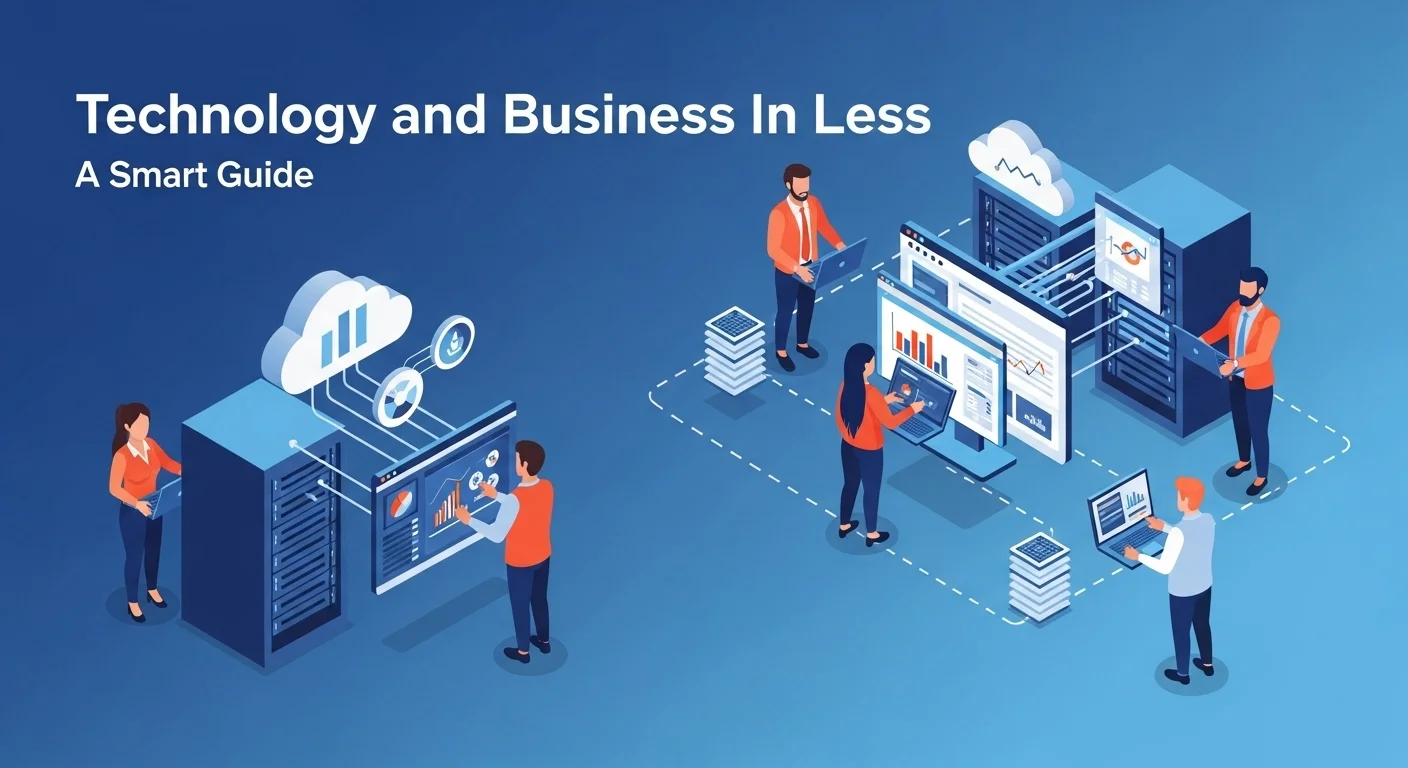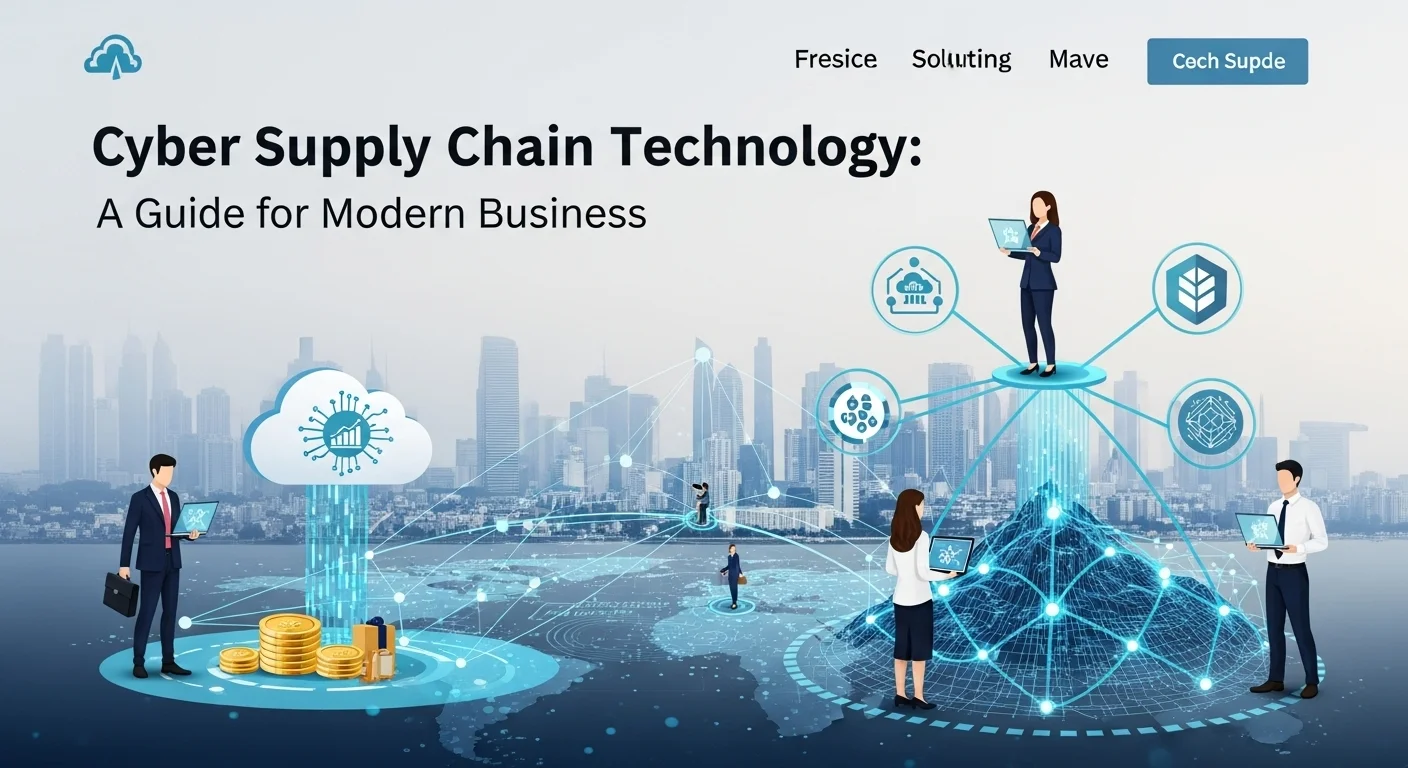The Smart Entrepreneur's Guide: Building a Business on a Shoestring Budget with Tech

Executive Summary
In my years as an entrepreneur, I've seen one myth cripple more dreams than any other: the idea that you need a mountain of cash to start a business. That's just not true anymore. We're living in an era of what I call 'Business In Less'—a smarter approach that's less about your bank account and more about your resourcefulness. It’s about using technology as your primary co-founder to build something amazing with minimal capital. Powerful tools like cloud computing, AI, and digital marketing platforms have completely leveled the playing field. You no longer need a huge upfront investment to compete with the big guys. This guide is my personal playbook on how to build a successful business with less. We'll walk through the specific tech you need, how to automate your work, find profitable business ideas, and turn a small investment into a thriving company. This is for anyone ready to build their dream without breaking the bank.
Table of Contents
Table of Contents
What Does 'Business In Less' Actually Mean?
The 'Business In Less' philosophy is a complete game-changer for entrepreneurs. I remember the old days when starting a business meant securing huge loans, renting office space, and buying tons of expensive equipment. 'Business In Less' throws that old rulebook out the window. It’s not about being cheap; it's about being incredibly smart with your resources. The whole idea is to keep your starting costs and daily expenses as low as possible, which lowers your financial risk and makes you incredibly nimble. It’s the art of doing more with less, and honestly, technology is what makes it all possible. Technology is the great equalizer, giving a one-person startup the kind of power that used to belong only to massive corporations. That's why building a business with less capital isn't just a possibility today; it's often the smartest path forward.
The Tech That Powers a Lean Business
Let's talk about the specific technologies that I see as the foundation of any 'Business In Less' venture. These are the tools that help you save money, boost productivity, and grow your business.
1. Cloud Computing: Forget Owning Expensive Servers
The cloud is, without a doubt, the number one enabler of a low-investment business. Back in the day, I had to buy, set up, and maintain physical servers. It was a costly, time-consuming nightmare. Now, services like Amazon Web Services (AWS), Google Cloud, and Microsoft Azure have changed everything. They let you 'rent' computing power, storage, and software on a pay-as-you-go basis. Think of it like electricity; you only pay for what you use.
- Infrastructure as a Service (IaaS): This is like renting a virtual computer. You can scale your power up or down instantly as your business needs change. It’s pure flexibility.
- Platform as a Service (PaaS): This gives you a ready-made environment to build and run your apps without worrying about the underlying hardware.
- Software as a Service (SaaS): This is probably the most familiar. Tools you subscribe to monthly, like Salesforce for sales, Slack for team chat, or QuickBooks for accounting. You get enterprise-level software for a tiny fraction of the old cost.
By using the cloud, you can launch a business with practically zero IT hardware costs, freeing up your cash for what really matters: improving your product and finding customers.
2. Artificial Intelligence (AI) and Automation: Your 24/7 Digital Assistant
AI is my secret weapon for efficiency. It automates the repetitive tasks that used to eat up my day. An AI-powered tool can help a small team punch way above its weight class.
- Smarter Marketing: AI can look at your customer data and figure out the best way to reach them, making your ad budget work harder. It can even help you write blog posts and social media updates, making it a key ingredient for a business with less investment and more profit.
- Automated Customer Service: AI chatbots are fantastic. They can handle common customer questions around the clock, so you don't have to. This massively cuts down on support costs and keeps customers happy.
- Streamlined Operations: I use AI for everything from organizing my finances to scheduling my meetings. It handles the boring back-office stuff so I can focus on growing the business.
Generative AI tools are a recent revolution. They let you create professional-quality text, images, and even code from a simple prompt. For a founder on a budget, this is like having a creative team on call for free.
3. Digital Marketing & E-commerce: Your Global Storefront
The internet is your direct line to customers worldwide, and it's where the best business ideas with less investment come to life.
- E-commerce Made Easy: Platforms like Shopify or BigCommerce let you build a beautiful online store in just a few days for a small monthly fee. No need for an expensive physical shop.
- Dropshipping: This is the ultimate 'Business In Less' model. You can sell products online without ever buying or storing inventory yourself. When an order comes in, your supplier ships it directly to the customer. Your job is simply to market the product.
- Cost-Effective Advertising: Forget expensive TV or print ads. Digital marketing lets you target your ideal customers with incredible precision for a much smaller budget. SEO, content marketing, and social media are powerful ways to reach people who are actively looking for what you offer.
Why This is the Best Way to Start a Business Today
This tech-powered 'Business In Less' approach isn't just a trend; it's a smarter way to build something that lasts.
- Lower Financial Risk: You can test your business ideas without betting the farm. This freedom to experiment is where real innovation happens.
- Be Quick and Agile: Without being weighed down by heavy costs or a large hierarchy, you can adapt to customer feedback in days, not months.
- Scale Smartly: The best lean businesses can grow without costs spiraling out of control. With cloud tools, you just upgrade your plan as you get more customers. You pay for growth as it happens.
- Go Global from Day One: Your first customer could be next door or on the other side of the world. The internet erases borders.
- Focus on What Counts: By automating the grunt work, you can pour all your energy into creating an amazing product and delivering fantastic customer service. In my experience, that's the real secret to building a business with less investment and more profit.
Embracing this model is the first and most important step to building a resilient, scalable, and profitable company in today's world.

My Complete Guide to Building Your Lean Business Machine
Alright, let's roll up our sleeves. Starting a 'Business In Less' isn't just about having an idea; it's about making smart, strategic tech choices from day one. This is my practical guide to building a strong, cost-effective foundation for your company. We'll look at the specific tools I recommend and the business mindset you need to turn a low-capital business into a success story.
Building Your Tech Stack: The Smart Entrepreneur's Toolbox
Your 'tech stack' is just a fancy term for the collection of digital tools that run your business. The goal here isn't to get the most expensive software, but the *right* software. We'll lean heavily on free plans and affordable, high-value services.
1. Your Digital Office (The Basics):
First things first, you need a place to work and collaborate. This can be set up for next to nothing.
- Productivity Tools: I run my entire business on Google Workspace. It gives me a professional email, cloud storage (Google Drive), and all the office apps I need. Microsoft 365 is another excellent choice. Both have very affordable starter plans.
- Team Communication: Slack is the virtual office for most startups. Its free version is incredibly powerful for messaging, sharing files, and making calls. For keeping projects on track, I'm a big fan of Trello for its simple, visual card-based system. Asana and ClickUp are also fantastic, with free plans perfect for small teams.
2. Your Digital Storefront (Website):
Your website is your most important marketing asset. It needs to look professional, but it doesn't have to cost a fortune.
- Domain & Hosting: You'll have to spend a little here, but it's minimal. I use Namecheap for domains. For hosting, a shared plan from a provider like SiteGround is a great, inexpensive place to start.
- Website Platform (CMS): WordPress.org is my go-to recommendation. It's free, open-source, and incredibly versatile. You can find thousands of free design themes and functional plugins to build almost any kind of site, from a blog to a full-featured online store. It's the engine behind a huge portion of the web for a reason.
3. Your Growth Engine (Marketing & Sales):
This is how you find customers and make money, a critical part of any business with less investment and more profit.
- Customer Relationship Management (CRM): You need a place to track your leads and customers. HubSpot's Free CRM is, in my opinion, one of the most generous and powerful free tools ever made available to small businesses. It's a no-brainer.
- Email Marketing: MailerLite is my top pick for beginners. Its free plan is robust and user-friendly, allowing you to build your email list and send campaigns without paying a dime until you grow.
- Social Media Scheduling: A tool like Buffer or Hootsuite lets you schedule your social media posts in advance. Their free plans save you a ton of time and keep your online presence consistent.
- Website Analytics: Google Analytics is non-negotiable. It's a free tool that tells you everything about your website visitors. Understanding this data is like having a roadmap for your business decisions.
4. Your Digital Bodyguard (Cybersecurity):
Don't ever think you're too small to be a target. A security breach can destroy a young business. Basic protection is easy and affordable.
- Password Security: Use a password manager. I use Bitwarden because its free version is excellent. It creates and saves strong, unique passwords for every site.
- Two-Factor Authentication (2FA/MFA): Turn this on for every single service you use. It's free and one of the single best things you can do to protect your accounts.
- Device Protection: Modern operating systems have good built-in protection, like Windows Defender. Just make sure it's always on and updated.
- Secure Browsing: When I'm working from a coffee shop or airport, I always use a trusted VPN to encrypt my connection and keep my data safe from prying eyes.
The Mindset and Methods of a Lean Entrepreneur
The right tools are useless without the right strategy. Here's how I approach building business ideas with less investment.
1. The Lean Startup Method:
This is my business bible. Instead of building a 'perfect' product in secret, you create a Minimum Viable Product (MVP)—the simplest version that solves a core problem. You get it into the hands of real users quickly, then you measure their feedback, learn, and improve. This 'Build-Measure-Learn' cycle stops you from wasting months building something nobody wants.
2. Growth Hacking & Content Marketing:
Forget big ad budgets. A lean business grows through clever, low-cost marketing. This is the playbook for a business with less investment and more profit.
- Content is King: I built my first business on the back of a blog. By writing helpful articles that solved my audience's problems, I built trust and attracted customers for free through Google searches (SEO). It takes time, but the return is incredible.
- Master SEO Basics: Learning how to get your website to show up on Google is the most valuable marketing skill you can have. It's a source of free, highly motivated customers.
- Build a Community: Don't just sell; connect. Engage with people on social media, answer questions in online forums, or start a simple Facebook Group for your customers. This builds incredible loyalty.
3. Tap into the Freelance Economy:
One of my best strategies for staying lean is to avoid hiring full-time employees until absolutely necessary. Platforms like Upwork and Fiverr are goldmines. I can hire a talented graphic designer for a logo, a writer for a blog post, or a developer for a small website fix, all on a project basis. You get world-class talent without the massive overhead of a salary.
How It All Stacks Up: Old vs. New
| Resource | Traditional Business | Modern 'Business In Less' |
|---|---|---|
| Office & Servers | Rent an office, buy servers. Huge upfront cost. | Work from anywhere, use cloud hosting. Low monthly cost. |
| Software | Buy expensive software licenses. | Subscribe to affordable SaaS tools (many with free plans). |
| Marketing | TV, print ads. Expensive and hard to track. | Digital marketing (SEO, content). Low cost and highly measurable. |
| Staff | Hire full-time staff. High fixed costs. | Hire freelancers as needed. Flexible and cost-effective. |
| Market Research | Costly focus groups and surveys. | Fast, data-driven A/B tests and analytics. Often free. |
As you can see, it's never been a better time to be an entrepreneur. By using technology intelligently, you can launch and grow a serious business. The 'Business In Less' path isn't about cutting corners; it's about being strategic, efficient, and laser-focused on growth.

Pro Tips: How to Master Your Tech and Future-Proof Your Business
Getting your lean business off the ground is just the beginning. The real magic happens when you continuously refine your processes and stay one step ahead. From my experience, long-term success comes from building good habits and knowing which tools will give you the biggest bang for your buck. Here are my advanced strategies to make sure your low-capital business doesn't just survive, but truly thrives and becomes the best business with less investment you can possibly build.
My Personal Best Practices for Sustainable Growth
These are the habits I've cultivated over the years that have paid off time and time again. They keep my operations lean, my customers happy, and my business growing.
1. Let Data Be Your Co-Pilot:
I cannot stress this enough: don't guess, know. Your data is a goldmine. Every Monday morning, I have a ritual of opening Google Analytics and my sales dashboard. I look for patterns. Which blog post brought in the most traffic? Which product had the highest conversion rate? This data tells me exactly what's working so I can do more of it, and what's not so I can stop wasting my time. This discipline is essential for creating a business with less investment and more profit.
2. Obsess Over the Customer Experience (CX):
In a noisy world, a fantastic customer experience is your secret weapon. I use technology to make every interaction with my brand smooth and enjoyable. This means a website that's blazing fast, especially on mobile. It means offering easy ways to get help, like a simple contact form or a chat widget. I also use my CRM to add little personal touches, like remembering a customer's past purchases. A happy customer not only comes back but also tells their friends—that's the best and cheapest marketing you can get.
3. Always Think About Tomorrow's Growth:
It's great to start with free tools, but I always look at the upgrade path. Before I commit to a platform, I ask: 'Can this tool grow with me?' If my business suddenly doubles, can this software handle it? Or will I be forced into a painful and expensive migration? Building the best business with less investment means choosing a foundation that won't crumble when you start succeeding.
4. Automate, Automate, Automate:
My personal rule is simple: if I have to do a repetitive digital task more than twice, I find a way to automate it. Tools like Zapier or Make are my best friends. They are like digital duct tape that connects all my different apps. For example, I have an automation that when someone buys a product from my store, they are automatically added to a specific email list, and a task is created for me to send a personal thank-you note a week later. Each little automation saves me time, prevents mistakes, and lets me focus on the work that actually grows the business.
A Deeper Look at My Favorite Business Tools
Let's go beyond the basics. These are some of the tools that I believe provide incredible value and can be the foundation for great business ideas with less investment.
- For Stunning Design (Even If You're Not a Designer) - Canva: Canva is a lifesaver. For a small monthly fee, I can create professional graphics for social media, ads, presentations—you name it. It saves me from having to hire a graphic designer for every little thing. It's an essential tool for any lean business that needs to look polished.
- For Building Custom Websites Without Code - Webflow: When a simple template won't cut it, I turn to Webflow. It lets you design incredibly custom, high-end websites visually. For entrepreneurs who have a unique vision for their online presence but can't afford a team of developers, this tool is a game-changer.
- For Free, Professional Accounting - Wave: So many startups make the mistake of managing their finances in a spreadsheet. It's a recipe for disaster. Wave is a fantastic, completely free accounting platform built for small businesses like ours. It connects to your bank, handles invoicing, and gives you the clean financial reports you need to make smart decisions.
A Resource I Genuinely Recommend
If you want to stay on top of how technology is shaping the startup world, you need to read what the experts are reading. I make it a habit to check TechCrunch daily. Their articles on how emerging startups are using new tech or finding creative growth strategies are incredibly insightful. For example, reading a case study on how a company used AI to personalize their user experience gives me practical ideas I can apply to my own business. Following them on social media like Twitter is a great way to get a constant stream of valuable, real-world insights.
What I'm Watching: The Future of Lean Business
To stay ahead, you have to look ahead. Here are a few trends I'm keeping a close eye on.
- Industry-Specific Software (Vertical SaaS): General tools are great, but software built specifically for your niche (e.g., for a fitness coach or a local plumber) can be incredibly powerful. As your business matures, actively look for these specialized tools.
- Web3 and Immersive Experiences: It's still early, but the ideas behind a more decentralized internet (Web3) and virtual worlds (the metaverse) are fascinating. I'm thinking about how these could open up new ways to connect with customers or even create new digital products.
- True Personalization with AI: The future is about creating unique experiences for every single customer. I'm excited about AI that can change a website's content on the fly based on who is visiting or craft a marketing email that feels like it was written just for one person. The businesses that master this will win.
Ultimately, running a 'Business In Less' is a continuous journey of learning and adapting. By following these best practices, using the right tools, and keeping an eye on the horizon, you can build an efficient, profitable, and future-proof company that punches far above its weight.
Expert Reviews & Testimonials
Sarah Johnson, Small Business Owner ⭐⭐⭐⭐
This was a solid overview. I run a small e-commerce shop, and while the concepts are great, I'd love to see a follow-up with a case study of a specific business, like mine, applying these tech tools step-by-step. Still very helpful!
Mike Chen, IT Consultant ⭐⭐⭐⭐⭐
As an IT guy, I appreciated the accurate breakdown of cloud services and security. I often tell my clients about this stuff, and this article explains the 'why' behind the tech in a way that's easy for non-tech founders to grasp. Good job.
Emma Davis, Aspiring Entrepreneur ⭐⭐⭐⭐⭐
Finally! An article that connects all the dots. I've been piecing together this 'lean startup' idea for months, and this guide laid out the exact tech stack and strategies I needed. The section on automation with Zapier was a game-changer for me. So much value here!



